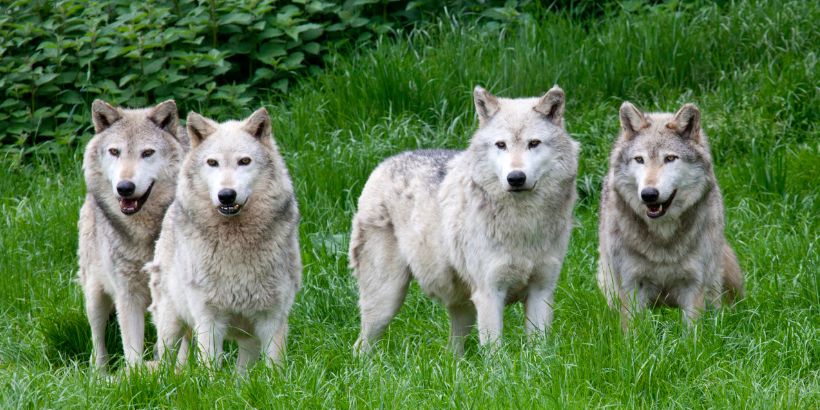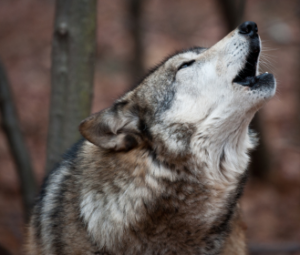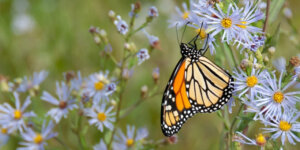Grey Wolves: The Howling Gods

Grey wolves are complicated, beautiful animals that are now absent in many parts of the world. Where did these creatures come from, and how did they get to where they are today?
The following is an excerpt from Hunt for the Shadow Wolf by Derek Gow. It has been adapted for the web.
Grey Wolves: Who Are They?
Grey wolves were domesticated in northern Eurasia between fourteen thousand and twenty-nine thousand years ago and are still considered to be the principal ancestor of the domestic dog.
They are great travellers that are well capable of covering vast distances with ease, with some individuals having been recorded as moving over five hundred miles.
Where they live in well-organised packs, they can kill large herbivores such as bison or moose, and specialise in ability. In Voyageurs National Park in northern Minnesota, beavers constitute 42 per cent of wolf diets between April and October.
The Diet Of Grey Wolves
Researchers there have identified that on average a single wolf in Voyageurs can consume between six and eight beavers a year.9
Elsewhere, in Alaska other wolves swim short distances out to sea to access offshore rock formations to predate bewhiskered sea otters that once believed they could lazily bask in peace.10
Despite this prowess, wolves will readily consume small mammals, rabbits, amphibians, fish, birds and even insects.
Bountiful Berries
When the brambles were ripe in Kent, my cubs would take a lip-smacking delight in the consumption of the dark purple, ripe berries when they were sugar rich.
Consumed in bulk, they turn poo bright purple (if you don’t believe me, you can prove it by using yourself, your kids or your parents as guinea pigs) and my wolves were no exception.
Although the ripe soft ones were a treat, the bitter red ones pruned by accident by their small front teeth would be met with a grimace before being swiftly spat out or wiped from their tongues with a forepaw.
Did Grey Wolves Consume Other Predators?
Given their broad dietary spread, it is entirely predictable that British wolves would have consumed other predators that we now consider to be sizeable.
A few years ago at dusk in Poland, I was out in a forest in the Masurian Lake region with a warden trying to observe elk. He informed me that, a few weeks before in the very same spot, he had been surprised to see a pair of unusual mammals with black-and-white striped faces.
Thinking that these might be raccoon dogs, which I had never seen before, I extracted a field guide from my backpack to agree their English name. When I showed him their picture, he said no, before eventually identifying the creatures he had observed as badgers.
When I told him how common these were in Britain, in vast setts of great age dug well back into dry woodland banks, he said that they could never live like that in Poland.
The Absence of Grey Wolves in Britain
When I asked why, he replied ‘wolves’ and, thinking back, this makes perfect sense.
If wolves lived in Britain, they would ambush badgers on their well-worn territorial paths that they use for evening ambles and, if they could, crunch them up completely while they slept in their snuggly beds.
While the badgers’ relaxed, sedentary lifestyle would revert to a rollercoaster ride from hell, wolves are also partial to foxes, and any otters planning the long-distance treks over mountains to view new river territories might also be in for a nasty surprise.
These adjustments in dominion for minor predators are what happens when a keystone king returns to claim its throne.
The Life of Grey Wolves
 While wolves can live well into their teens in captivity, any wolf over ten years of age in the wild is old. Large packs of up to two dozen individuals have been recorded although those numbering between six and ten are more common.
While wolves can live well into their teens in captivity, any wolf over ten years of age in the wild is old. Large packs of up to two dozen individuals have been recorded although those numbering between six and ten are more common.
Where severe persecution has occurred in the past, or if they start to colonise new ranges, single individuals or pairs can be the norm for a time.
Packs that comprise an adult breeding pair together with their attendant offspring of various ages have members with distinct characters and strong social bonds can form between different personalities.
The alpha pair assert continuous dominance over their subordinates and, in doing so, dictate the activities of the pack.
Caring For Cubs
Although the alpha female principally takes care of her cubs, many of the other pack members will bring food that they regurgitate for her at the den.
As the cubs grow stronger, adult wolves who are not their parents will bring food to them directly or play with them when their mother is absent.
A wolf pack’s territory varies in extent depending on both habitat quality and prey abundance and, once formed, a territorial pack will defend whatever landscape it occupies vigorously against neighbouring packs.
Wolves communicate with one another by visual signal, scent marking and howls that enable individuals to remain in contact and strengthen social bonds.
How Grey Wolves Grow
They breed between February and April with around five to six dark chocolate, blind cubs being born in an underground den after a gestation period of around two months.
After a few weeks, the pups are usually moved from their place of birth to a location where they can play above ground while the adults hunt.
They grow rapidly and are moved further and more often as the summer progresses until, with the onset of autumn, they begin to follow their pack through its wider territory.
After two or more years, some move away to find their own mates or establish new territories.
Enemies of Grey Wolves
Large ungulates such as elk and wild boar will attack wolf cubs when they encounter them above ground.
Given the deadly determination my Heck cattle expressed in a tails up, horns down, bellowing rampage whenever my sheepdogs entered their paddocks, I cannot imagine that aurochs and wisent would not in the past have done the same.
One study in the Naliboki Forest of Belarus identified that large male lynx will readily enter wolf dens and force the females out in order to kill their entire litters of cubs.
Nature: The Ultimate Level
Between 2012 and 2016, when the lynx population began to rise, 63 per cent of the wolf pups produced were killed by them, and between 2016 and 2017, as lynx became common, this figure rose to 96 per cent.
In the end, their predation by lynx became so thorough that wolves only survived in the study site as a result of other subadults’ immigration from elsewhere.11
Nature is a great leveller of balance.
Notes
9. Dan Kraker, ‘The Secret Lives of Wolves in Voyageurs National Park: They Fish and Eat Berries’, MPR News, 17 December 2018, https://www.mprnews.org/ story/2018/12/17/the-secret-lives-of-wolves-at- voyageurs-national-park-they-fish-and-eat-berries.
10. Margaret Osborne, ‘In Alaska, Hungry Wolves Have Started Eating Sea Otters’, Smithsonian Magazine,
26 January 2023, https://www.smithsonianmag.com/ smart-news/in-alaska-hungry-wolves-have-started-eating- sea-otters-180981509.
11. Vadim Sidorovich, ‘Findings on the Interference Between Wolves and Lynxes’, Zoology by Vadim Sidorovich (blog), 6 September 2017, https://sidorovich.blog/2017/09/06/ wolves-and-lynxes.
Recommended Reads
Recent Articles
For too long, bugs have had a negative connotation associated with them. But what if we took the time to observe the benefits of insects? It’s time to rebug our gardens, lawns, and parks! The following is an excerpt from Rebugging the Planet by Vicki Hird. It has been adapted for the web. Adding Bugs:…
Read MoreAsparagus is a delicious vegetable with a layered history. How did this aspiring spear make its way from growing in the wild to appearing on our plates? The following is an excerpt from the The Seed Detective by Adam Alexander. It has been adapted for the web. “Nature gives us the key to every secret…
Read MoreChances are, you’ve seen cattails growing on the edge of your local lake or stream at least once or twice. Instead of just passing these plants, try foraging for and cooking them to create delicious seasonal dishes! The following excerpt is from The New Wildcrafted Cuisine by Pascal Baudar. It has been adapted for the…
Read MoreGarlic mustard: while known as “invasive,” this plant can be consumed in its entirety and has great nutritional value. Plus, the garlic-flavor is a perfect addition to any recipe that calls for mustard! The following are excerpts from Beyond the War on Invasive Species by Tao Orion and The Wild Wisdom of Weeds by Katrina…
Read MorePeregrine falcons, while known as predators, are essential to our environment. These stunning birds have a rich history, an interesting present, and an uncertain future. The following is an excerpt from Feather Trails by Sophie A. H. Osborn. It has been adapted for the web. Who Are Peregrine Falcons? Though relatively uncommon wherever it occurs,…
Read More

![The Hunt for the Shadow Wolf [US Edition] cover](https://www.chelseagreen.com/wp-content/uploads/9781915294463-300x469.jpg)
![The Lost Flock [US Edition] cover](https://www.chelseagreen.com/wp-content/uploads/9781915294395-399x600.jpg)






